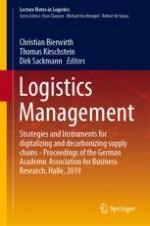2019 | Buch
Logistics Management
Strategies and Instruments for digitalizing and decarbonizing supply chains - Proceedings of the German Academic Association for Business Research, Halle, 2019
herausgegeben von: Prof. Dr. Christian Bierwirth, Dr. Thomas Kirschstein, Prof. Dr. Dirk Sackmann
Verlag: Springer International Publishing
Buchreihe : Lecture Notes in Logistics
